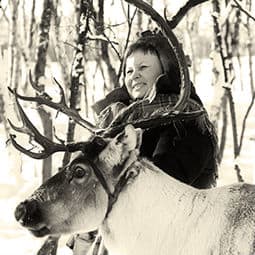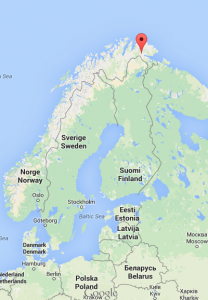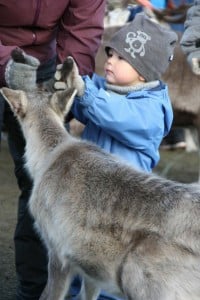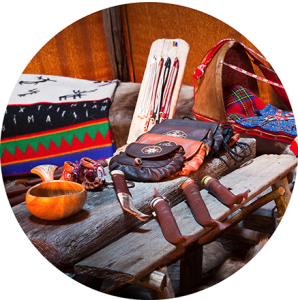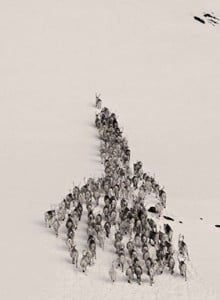Reindeer Rules: The Sami Way of Life
Spread across the northernmost regions of Scandinavia, there’s a people that conquer freezing conditions every day in order to work and live. It’s the Sami, the indigenous people of Scandinavia, whose main business and lifestyle have revolved around reindeer for centuries. Here, reindeer herder Ellinor tells us about the Sami way of life.
By Anne Brugts, Content Manager, Story Terrace
It’s 4 p.m. in Norway. If Ellinor Guttorm Utsi were to look outside, there would be no sun, just darkness. ‘Today it got dark around an hour ago. That’s late; in December there’s only a few hours of light. Still, we always have some kind of light, like the northern lights or blue light from the moon, the stars. It will never be totally dark.’
The Pace of the Animal
Ellinor is currently in Tana, a little village close to the Finnish border. For the moment, that is. The Sami travel with their reindeer and the animals’ rhythm sets the Sami pace. ‘We move with the reindeer’, explains Ellinor. ‘The animals have a natural instinct that drives them from winter land to summer land. Winter land is near the Finnish border, summer land is at the coast. In April they start moving slowly northwards to the water.’
She inherited her parents’ reindeer and her husband added his own herd to the group. At the moment he works in the mountains. He stays with the reindeer as they move, day by day, from one place to another. ‘When we move is decided by nature and by the reindeer. If they’re out of food we move, and if weather is bad, we move as well, from hut to hut. We flock them together, see if there’s enough food under the snow. You have to watch them all the time, because there’s always one that tries to get away at night.’
Ellinor stays at home with the kids, preparing handicrafts. ‘Handicrafts are a big part of Sami culture as well. We use different parts of the skin to prepare garments, such as shoes.’
Growing Up Sami
As the child of reindeer herders, Ellinor grew up conscious of her Sami background. ‘My father was in the mountains most of the time. Mother would stay home with the children, making handicrafts.’ But their main source of income was selling reindeer. Never ask a Sami how many reindeer they have, though. ‘It’s like I’m asking you how much money is in your bank account.’
When Ellinor grew up, there was strong Norwegian rule over the Sami people. ‘The government wanted all Sami to speak Norwegian. Luckily, my parents lived in a small village where we didn’t feel much the Norwegian influence as much. I lived close to nature and the reindeer.’
The grip loosened over the years and now kids at school can choose which language will be their first. ‘My daughter’s teacher came up to me to ask about her preferred language. I got so angry. “Is that even a question?” I asked her. I never felt I had to be anything other than Sami, and I want the same for my kids.’
A Reindeer’s Mentality
Sami custom dictates that only one child in the family can inherit the reindeer business. Usually it’s the boy, but since Ellinor’s only brother inherited her uncle’s herd first, she was lucky and brought up a herder. ‘From the age of twelve, I’d go into the mountains with my father.’
A very special childhood memory is when she first marked a reindeer. ‘The animals have to be marked to be able to track them. In order to do so, you have to catch them and that is quite a difficult job. I was thirteen or fourteen and my father didn’t tell me a lot about it. He just told me to do it. Sami parents don’t use a lot of words. You learn by doing, that’s how the Sami differ from Norwegian children. They have to find out by themselves. I still remember the feeling that arose when I’d done it by myself. I was so proud.’
To outsiders, taming and controlling such a strong animal seems nearly impossible. Ellinor argues otherwise, though. ‘When you know them, and you know the way they think, it’s no problem taming them. They’re very strong and proud, as they ought to be, living in the cold. They know how to survive and they teach us to do the same. In that way, they’ve shaped our tradition and culture.’
Nature Over Rules and Culture
Today, Ellinor’s husband drove out to the herd to check on them. Lynx are active in the area. According to Ellinor, there’s no threat from the wild animals to humans, though. There’s the usual danger of getting caught in a snowstorm while working, though. ‘You get used to it, learn how to dress and how to act. Sometimes the snow will be so heavy that you won’t see a thing. Everything around you is white and you’ll have to stop driving and wait. After the storm, it will be sunny, that’s what we say. I don’t think of it as a risk; it’s just part of our life.’
Apart from herding their reindeer and selling their handicrafts, Ellinor is the leader of a project that aims to enhance Sami tourism. ‘For years, Sami culture and tradition was spread by people other than the Sami. Often, they’ve shared misinformation and now it’s important that we tell our story ourselves.’ Together with tourist agencies, she organizes activities to share the Sami culture with those who are interested. ‘The tourists come to us by ship from the north of Norway. We show them our culture and lifestyle today, as we teach them a little of our language, invite them into a Labo, a Sami tent, and have a camp fire outside.’
A Sami Future
There’s still a lot of young Sami who want to be in the reindeer business. Ellinor reflects: ‘That’s a sign; it tells me that we’re leading a good life. It’s a life without excessive money. We only need what is necessary.’
But at the same time, the Sami are fighting to stand their ground against the Norwegian government and its land development programs. ‘They want to expand industries, look for gold, make wind parks, build big roads, etc. We don’t deny technology; we recognize that we’re part of a world where it’s inevitable, but we do want to spread our message. We’ve used the land for hundreds of years and it has to be there for many more generations to come. “Will we be proud of Norway in fifty years? What will we be proud about?” I ask politicians. ‘We have to take care of tradition, take care of nature and the Sami people.’
For more information on Sami tourism check Ellinor’s website: www.davvisiida.no
____________
About us: Story Terrace helps customers to capture personal stories in beautiful books alongside a professional writer. Our writers have a range of backgrounds and interests, sharing one passion: Portraying individuals through carefully crafted anecdotes and lively stories.
For more information on having your stories written down, send an e-mail to info@ or get in touch via our contact form.
This month we serve up stories in our monthly theme ‘Icy adventures’. Also read our article ‘The Life of a Ski Instructor’. What’s your most adventurous story in snow and ice?

